Shenzhou-14 crewed mission arrives at Chinese space station
Sunday, 05 June 2022 09:10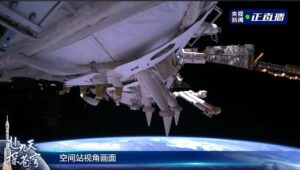
China’s Shenzhou-14 crewed spacecraft docked with the Tianhe space station module early Sunday, marking the start of a crucial six-month-long mission.
China sends three astronauts to complete space station
Sunday, 05 June 2022 06:34 China on Sunday launched a rocket carrying three astronauts on a mission to complete construction on its new space station, the latest milestone in Beijing's drive to become a major space power.
The trio blasted off in a Long March-2F rocket at (0244 GMT) from the Jiuquan launch center in northwestern China's Gobi desert, said state broadcaster CCTV, with the team to spend six months expandi
China on Sunday launched a rocket carrying three astronauts on a mission to complete construction on its new space station, the latest milestone in Beijing's drive to become a major space power.
The trio blasted off in a Long March-2F rocket at (0244 GMT) from the Jiuquan launch center in northwestern China's Gobi desert, said state broadcaster CCTV, with the team to spend six months expandi China launches mission to complete space station assembly
Sunday, 05 June 2022 05:40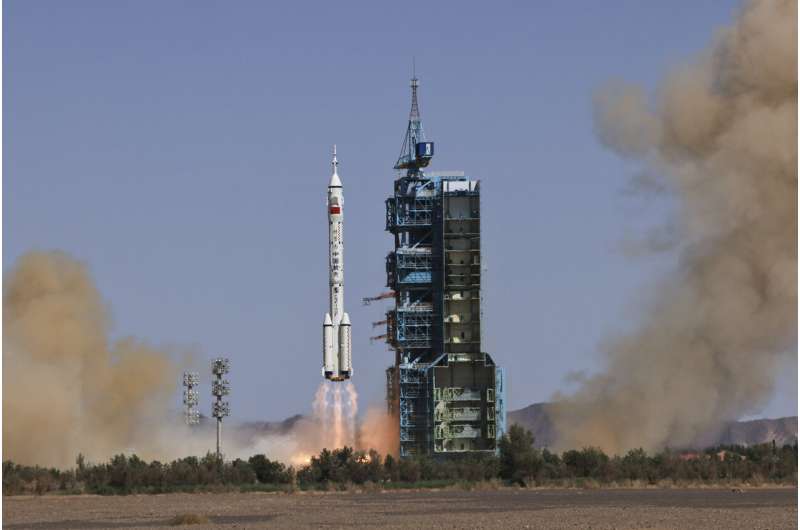
China on Sunday launched a new three-person mission to complete assembly work on its permanent orbiting space station.
Bezos's Blue Origin makes 5th crewed flight into space
Saturday, 04 June 2022 20:52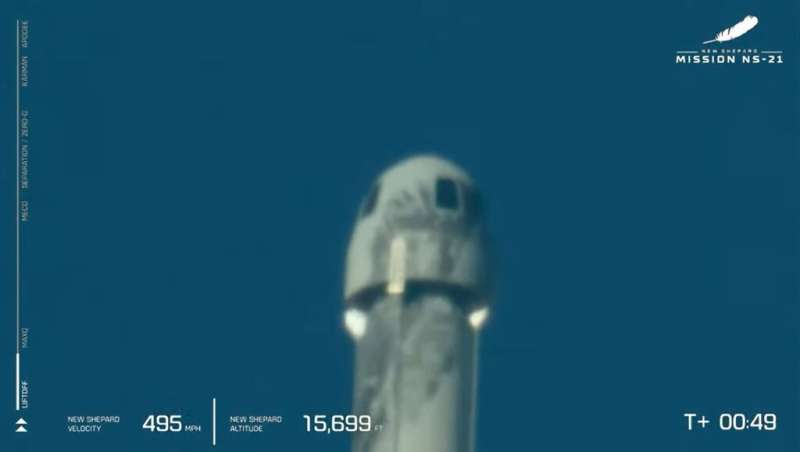
Jeff Bezos's company Blue Origin flew six tourists into space for a 10-minute ride Saturday, successfully carrying out its fifth crewed mission.
The white spacecraft called New Shepard lifted off with a roar from a desert spot in west Texas at 8:26 local time (1326 GMT).
The crew hooted with glee as the rocket reached space, a Blue Origin webcast showed.
The flight included engineer Katya Echazarreta, who at 26 became the youngest American woman in space. The Guadalajara native also became the first Mexican-born woman to go into space.
New Shepard completes fifth crewed suborbital flight
Saturday, 04 June 2022 13:08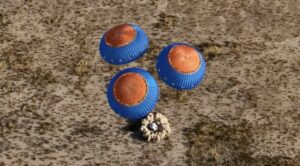
Blue Origin’s New Shepard suborbital vehicle performed its fifth crewed suborbital flight June 4, carrying six people including the first Mexican-born woman to go to space and the company’s first repeat customer.
China plans to complete space station with latest mission
Saturday, 04 June 2022 07:26
Sony launches space laser communications business
Friday, 03 June 2022 18:01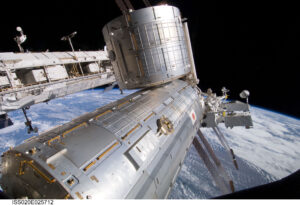
Sony has formed a company to develop laser communications equipment for small satellites, drawing on optical disc technology it pioneered for CD players and other devices.
The post Sony launches space laser communications business appeared first on SpaceNews.
Russia's supply ship arrives at International Space Station
Friday, 03 June 2022 13:18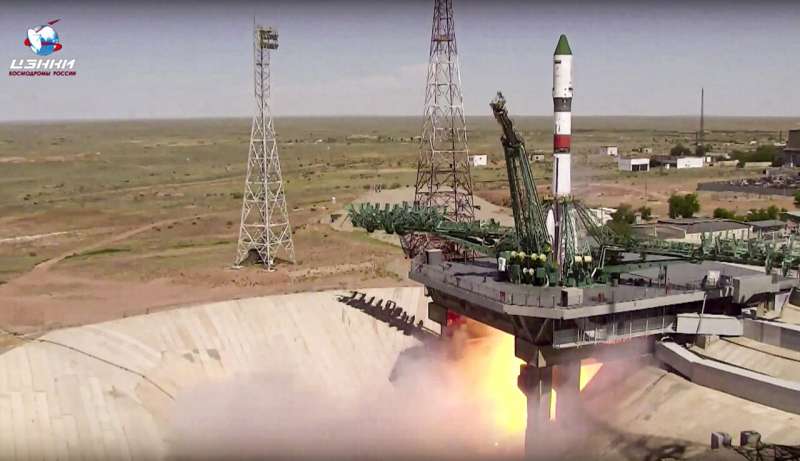
What the Voyager probes can teach humanity about immortality and legacy
Friday, 03 June 2022 12:31 Voyager 1 is the farthest human-made object from Earth. After sweeping by Jupiter, Saturn, Uranus and Neptune, it is now almost 15 billion miles (24 billion kilometers) from Earth in interstellar space. Both Voyager 1 and its twin, Voyager 2, carry little pieces of humanity in the form of their Golden Records. These messages in a bottle include spoken greetings in 55 languages, sounds and images
Voyager 1 is the farthest human-made object from Earth. After sweeping by Jupiter, Saturn, Uranus and Neptune, it is now almost 15 billion miles (24 billion kilometers) from Earth in interstellar space. Both Voyager 1 and its twin, Voyager 2, carry little pieces of humanity in the form of their Golden Records. These messages in a bottle include spoken greetings in 55 languages, sounds and images Perseverance Has a Pet Rock!
Friday, 03 June 2022 12:31 How do you choose a rock on Mars? Sometimes you don't- it chooses you. For the past 4 months, Perseverance has had an unexpected traveling companion. Back on sol 341- that's over 100 sols ago, in early February- a rock found its way into the rover's front left wheel, and since hitching a ride, it's been transported more than 5.3 miles (8.5 km). This rock isn't doing any damage to the wheel, but
How do you choose a rock on Mars? Sometimes you don't- it chooses you. For the past 4 months, Perseverance has had an unexpected traveling companion. Back on sol 341- that's over 100 sols ago, in early February- a rock found its way into the rover's front left wheel, and since hitching a ride, it's been transported more than 5.3 miles (8.5 km). This rock isn't doing any damage to the wheel, but NASA selects new instruments for priority Artemis science on Moon
Friday, 03 June 2022 12:31 Adding to the growing list of commercial deliveries slated to explore more of the Moon than ever before under Artemis, NASA has selected two new science instrument suites, including one that will study the mysterious Gruithuisen Domes for the first time.
These payload suites mark the second selection through the agency's Payloads and Research Investigations on the Surface of the Moon (PRIS
Adding to the growing list of commercial deliveries slated to explore more of the Moon than ever before under Artemis, NASA has selected two new science instrument suites, including one that will study the mysterious Gruithuisen Domes for the first time.
These payload suites mark the second selection through the agency's Payloads and Research Investigations on the Surface of the Moon (PRIS Student-Built, Dime-Sized Instrument Is Venus-bound on NASA's DAVINCI
Friday, 03 June 2022 12:31 Greenbelt MD (SPX) Jun 03, 2022
Venus Oxygen Fugacity (VfOx) is a small, button-sized sensor aboard NASA's DAVINCI mission to Venus' atmosphere that will be designed, fabricated, tested, operated, and analyzed by undergraduate and graduate students as the mission's Student Collaboration Experiment.
Planned for launch in 2029, the DAVINCI mission (Deep Atmosphere Venus Investigation of Nob
Greenbelt MD (SPX) Jun 03, 2022
Venus Oxygen Fugacity (VfOx) is a small, button-sized sensor aboard NASA's DAVINCI mission to Venus' atmosphere that will be designed, fabricated, tested, operated, and analyzed by undergraduate and graduate students as the mission's Student Collaboration Experiment.
Planned for launch in 2029, the DAVINCI mission (Deep Atmosphere Venus Investigation of Nob NASA's DAVINCI Mission To Take the Plunge Through Massive Atmosphere of Venus
Friday, 03 June 2022 12:31 In a recently published paper, NASA scientists and engineers give new details about the agency's Deep Atmosphere Venus Investigation of Noble gases, Chemistry, and Imaging (DAVINCI) mission, which will descend through the layered Venus atmosphere to the surface of the planet in mid-2031. DAVINCI is the first mission to study Venus using both spacecraft flybys and a descent probe.
DAVINCI,
In a recently published paper, NASA scientists and engineers give new details about the agency's Deep Atmosphere Venus Investigation of Noble gases, Chemistry, and Imaging (DAVINCI) mission, which will descend through the layered Venus atmosphere to the surface of the planet in mid-2031. DAVINCI is the first mission to study Venus using both spacecraft flybys and a descent probe.
DAVINCI, Algorithm simulates intergalactic medium of the Universe in seconds
Friday, 03 June 2022 12:31 The Instituto de Astrofisica de Canarias (IAC) has led the development of a new numerical procedure that allows to reproduce in a few seconds with Big Data and machine learning techniques the intergalactic medium obtained from a cosmological simulation of 100,000 hours of computation. Thanks to this algorithm, called Hydro-BAM, researchers have been able to exploit the hierarchy in the relations
The Instituto de Astrofisica de Canarias (IAC) has led the development of a new numerical procedure that allows to reproduce in a few seconds with Big Data and machine learning techniques the intergalactic medium obtained from a cosmological simulation of 100,000 hours of computation. Thanks to this algorithm, called Hydro-BAM, researchers have been able to exploit the hierarchy in the relations Close encounter more than 10,000 years ago stirred up spirals in accretion disk
Friday, 03 June 2022 12:31 Dr. LU Xing, an associate researcher from the Shanghai Astronomical Observatory (SHAO) of the Chinese Academy of Sciences, along with collaborators from Yunnan University, the Harvard-Smithsonian Center for Astrophysics, and the Max Planck Institute, have used high-resolution observational data from the Atacama Large Millimeter/submillimeter Array (ALMA) to discover a massive protostellar disk i
Dr. LU Xing, an associate researcher from the Shanghai Astronomical Observatory (SHAO) of the Chinese Academy of Sciences, along with collaborators from Yunnan University, the Harvard-Smithsonian Center for Astrophysics, and the Max Planck Institute, have used high-resolution observational data from the Atacama Large Millimeter/submillimeter Array (ALMA) to discover a massive protostellar disk i 